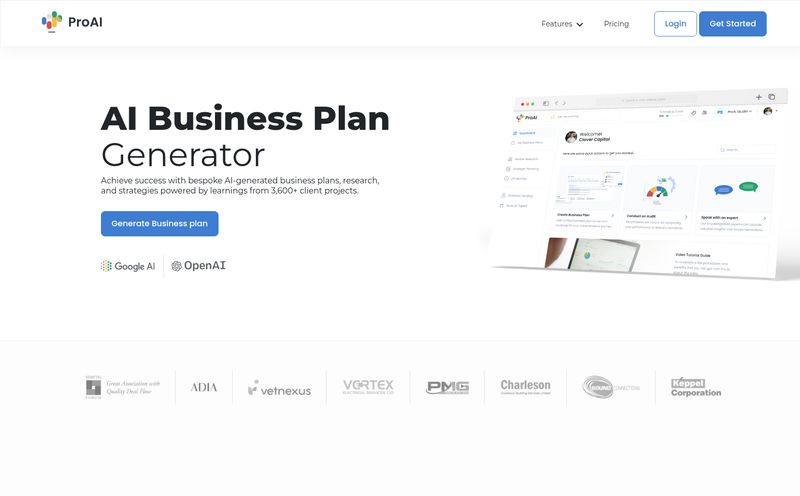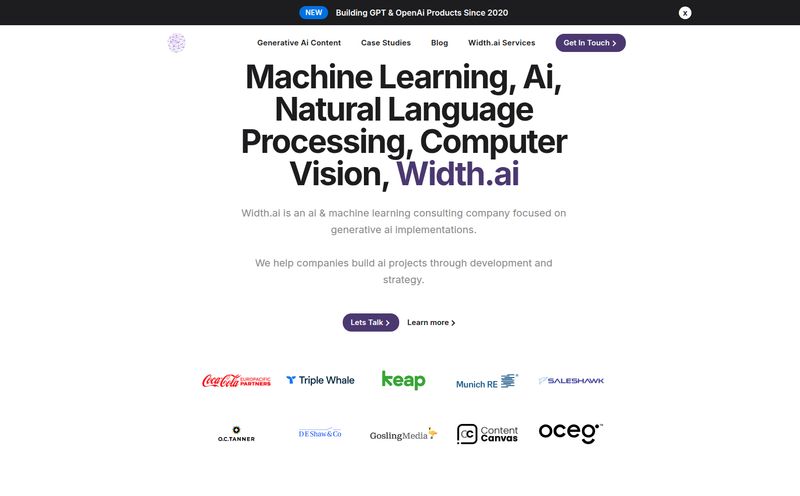If you’ve worked in tech for more than a week, you've known the unique, soul-crushing pain of making a diagram. You know the one. The network topology diagram that was outdated the second you exported it. The cloud architecture chart that looks like a plate of spaghetti dropped from a great height. I’ve spent more hours of my life than I’d care to admit nudging a box in Visio one pixel to the left. Then back to the right. Infuriating.
We’ve all been there, trying to make things look professional while our actual cloud environment quietly changes in the background, rendering our beautiful diagram a work of historical fiction. For years, we've just accepted this as part of the job. A tedious, manual, digital janitorial task. Well, I just stumbled across a tool called CodableAI that’s making some pretty bold claims about ending this madness, and I have to say, I'm intrigued.
So, What is CodableAI Anyway?
At its core, CodableAI is an AI-powered platform designed to turn your textual descriptions of a system into a clean, professional, and—this is the important part—intelligent diagram. Instead of dragging shapes and connecting lines until your eyes cross, you simply describe your architecture. The AI then takes over, generating the visual representation for you. Think of it like Infrastructure as Code (IaC), but for your documentation. A sort of Documentation-as-Code, if you will.
It’s built for everyone from scrappy startup teams trying to get on the same page, to enterprise architects enforcing standards, to the DevOps engineers in the trenches who just want a visual of the infrastructure they’re about to deploy. Right now, it looks like they're in a pre-launch phase, with a waitlist you can join. That always adds a little bit of mystique, doesn't it?
The Old Way vs. The CodableAI Promise
The Nightmare of Manual Diagramming
The status quo for most of us is a clunky diagramming tool. It's static. A snapshot in time. A polaroid of a live concert – it’s outdated teh second you take it. There's zero connection between the diagram on your screen and the actual resources humming away in your AWS, Azure, or GCP account. This disconnect is more than just an annoyance; it leads to miscommunication, flawed planning, and onboarding headaches for new team members who are looking at a map of a country that no longer exists.

Visit CodableAI
How CodableAI Wants to Change the Game
CodableAI’s approach feels like a breath of fresh air. It’s a simple, three-step dance:
- Describe your Architecture: You start by writing out what your system looks like, using natural language or specific parameters. For instance, “A web application with a load balancer, two EC2 instances in an auto-scaling group, and an RDS database.”
- AI Generates the Diagram: The platform’s AI parses your description and builds the diagram. It understands relationships, groups components logically, and applies a clean, consistent layout. No more crooked lines.
- Refine and Collaborate: From there, you and your team can tweak the diagram, add details, and collaborate in real-time.
This simple shift from drawing to describing is the whole foundation of the tool’s appeal. It’s about focusing on the logic of your system, not the aesthetics of a diagram.
Digging into the Features That Actually Matter
A cool concept is one thing, but the devil is in the details. After poring over their site, a few features really stood out to me as potential game-changers.
Live Cloud Integration: The Holy Grail?
Okay, this is the one. This is the feature that made me sit up and pay attention. CodableAI claims it will have live cloud integration. This means it can connect to your actual cloud environment and keep your diagrams automatically up-to-date. If a developer spins up a new instance or a service is decommissioned, the diagram reflects that change. Automatically.
If they pull this off, it single-handedly solves the biggest problem with infrastructure documentation. Your diagrams would finally become a reliable source of truth, not just a pretty picture for a PowerPoint slide. Remember that Polaroid I mentioned? This feature turns it into a live stream.
Performance Simulation and Cost Estimation
Here’s another feature that elevates CodableAI from a simple documentation tool to a strategic planning asset. The ability to simulate performance and estimate costs before you deploy is huge. You could map out a new microservice, and the tool could potentially give you a ballpark of your monthly AWS bill and identify potential performance bottlenecks. This is the kind of proactive insight that saves companies a ton of money and headaches down the line.
Smart Layouts and Team Stuff
Of course, it has the quality-of-life features you’d expect. The AI-powered auto-layout promises to keep everything perfectly aligned, saving countless hours of fiddling. It also has real-time team collaboration, which is table stakes these days but still essential. What’s interesting is the idea of “Intelligent Nested Diagrams,” where the AI automatically groups components into logical layers, allowing you to zoom in on a specific microservice or zoom out for a high-level system overview. That's a really smart way to handle complexity.
Who is This Tool Really For?
The website calls out a few key groups, and I think they're spot on.
- Startup & DevOps Teams: For fast-moving teams, being able to quickly visualize and plan new features or infrastructure without getting bogged down in a diagramming tool is a massive win. It helps with communication and faster, more accurate deployments.
- Enterprise Architects: In large organizations, maintaining standards and providing clear architectural documentation is a full-time job. A tool that can automate much of this and ensure consistency across hundreds of projects could be invaluable.
- Educational Institutions: I can see this being an amazing teaching aid. Instead of just learning theory, students could describe an architecture and instantly see it brought to life, helping them grasp complex concepts much faster.
The Big Question: Pricing and Availability
Here's the million-dollar question. As of right now, CodableAI's pricing is not public. The site funnels you to a waitlist. This is pretty standard for a product in its early stages. My guess? We'll likely see a tiered model. Maybe a free tier for basic diagrams, a pro tier for individual power users with some cloud integrations, and an enterprise tier for large teams with all the bells and whistles like SSO and advanced security features. But that’s all just speculation on my part. For now, getting on the waitlist is the only way to find out.
My Honest Take (A Little Skepticism is Healthy)
Look, I’ve been in this industry long enough to know that you should always greet shiny new tools with a healthy dose of skepticism. The promises are big. Really big. And while I'm genuinely excited, there are a few things to keep in mind.
The information is still a bit limited. We're seeing the polished landing page, not the nitty-gritty of the tool in action. How well does the AI really understand complex, non-standard architectures? How seamless is that live cloud integration, really? And there's always the risk that leaning too heavily on an AI tool like this might make some of us a bit lazy, reducing our own independent problem-solving muscles. These are the things we'll only know once it's out in the wild.
That said, the problems CodableAI is trying to solve are so real and so universal that I’m rooting for them. Hard.
Frequently Asked Questions about CodableAI
How does the AI understand my requirements?
From what I gather, it uses Natural Language Processing (NLP) to parse your text descriptions. You likely provide prompts that detail your components (e.g., servers, databases, load balancers) and their relationships, and the AI translates that into a visual diagram. It probably also recognizes specific keywords for AWS, GCP, and Azure services.
How is CodableAI different from tools like Lucidchart or Visio?
The key difference is the workflow. With traditional tools, you manually draw the diagram. With CodableAI, you describe the system and the AI draws it for you. The other massive difference is the planned live cloud integration, which keeps the diagram in sync with your actual infrastructure—something static tools just can't do.
When will CodableAI be available?
There's no public release date yet. The only official action is to join the waitlist on their website. This suggests it's in a private beta or nearing a public beta release.
Can I import diagrams from other tools?
The website doesn't explicitly state this, but it's a common feature request for new tools in this space. It would be a smart move for them to include importers for Visio or Draw.io to ease migration, but we'll have to wait and see.
What kind of diagrams can I build?
It seems focused on technical system diagrams. The site lists cloud architectures (AWS, GCP, Azure), network topologies, database schemas, CI/CD pipelines, and even big data processes. It’s definitely geared towards software and infrastructure visualization.
Is CodableAI Worth Joining the Waitlist For?
My verdict? Absolutely. Yes.
Even with my healthy dose of industry cynicism, I can't ignore the potential here. The pain of manual diagramming is a deep and universal one in our field. A tool that promises not only to automate the creation but also to keep the documentation alive and accurate via cloud sync isn't just an incremental improvement—it's a fundamental shift in how we approach technical documentation.
Will it live up to all the hype? The jury's still out. But is it one of the most exciting new tools I've seen for DevOps and system architecture in a long time? Without a doubt. I've already put my name on the waitlist. I suggest you do too. It might just be the thing that finally lets us escape drag-and-drop hell for good.
References and Sources
- CodableAI Official Website: [A placeholder link, assuming the website is codable.ai based on the logo]
- AWS Well-Architected Framework: https://aws.amazon.com/architecture/well-architected/



